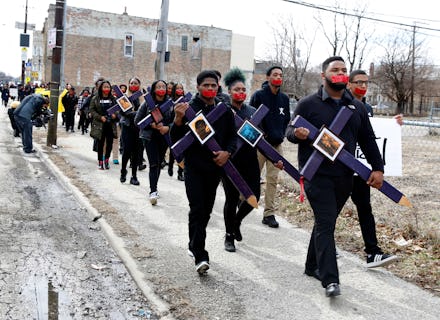National Walkout Day detentions highlight concerns about racial bias in police response to protests

By many accounts, Wednesday’s National Student Walkout was historic. An estimated 1 million middle and high school students of all races and backgrounds participated in the anti-violence demonstrations, with many either standing, kneeling or marching for 17 minutes in honor of the 17 people killed in the mass shooting at Marjory Stoneman Douglas High School in Parkland, Florida, on Feb. 14.
Organizers counted over 3,000 registered walkouts in 50 states and the District of Columbia. But not all students returned to class immediately after the official protest ended. In Chicago, groups of predominantly black students continued their march beyond school grounds and into a busy local intersection. Police handcuffed two students, according to a reporter who tweeted from the scene, and drove one to the station before releasing her.
According to Pete Grieve, co-editor-in-chief of the Chicago Maroon, the University of Chicago newspaper, a 16-year-old female student, who appears to be black, was taking into police custody for walking into traffic lanes at Lake Shore Drive and 47th Street. In a statement released by the Chicago Police Department and tweeted by Grieve, the student was handcuffed, taken into custody for “reckless conduct” and transported to a precinct. She was later released and returned to school. The CPD statement said authorities were reviewing whether to charge her.
Images of police detaining the 16-year-old female student and another male student who appears to be black, the latter of whom was also released, riled national racial justice groups. Before Wednesday, some activists said they felt school officials and law enforcement have responded differently to nonwhite students participating in social movements such as Black Lives Matter. It was unclear Thursday if white students had been handcuffed at any of the participating locations.
“This is terrible,” the Advancement Project, a national civil rights organization fighting the school-to-prison pipeline, tweeted Wednesday in response to Grieve’s photo of a student being handcuffed. The school-to-prison pipeline is a term often used among activists to point out the criminalization of youths in an educational setting.
“Police targeting black students for using their right to free speech,” the group said. “This is exactly why we can’t put more police in our schools.”
The Advancement Project echoed a debate sparked shortly after the Parkland shooting. Lawmakers in Florida and elsewhere have proposed assigning more police officers to public schools, despite years of data showing that black and brown students face harsher punishment and a disproportionate number of referrals to law enforcement compared to their white peers.
On Wednesday, several other walkouts involving predominantly black and brown students were not disrupted by students being handcuffed. In Broward County, Florida, students from area high schools walked out of classes and marched down roadways with a police escort.
More broadly, movement activists have said the Parkland-led gun control debate must not ignore gun violence in communities of color — like the most neglected neighborhoods of Chicago’s South Side — or legislative remedies that could slow the flow of handguns into illegal street markets. Much of the debate has centered on assault rifle bans, increased age restrictions for gun buyers and more robust federal background checks.